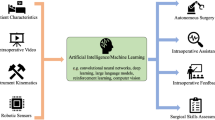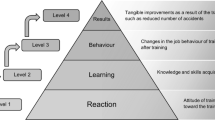Abstract
Background
This study aimed to investigate whether basic laparoscopic skills acquired with a virtual reality simulator (LapVR™) are transferable to a standard video trainer (VT) and vice versa.
Methods
Three basic tasks were considered: peg transfer, cutting, and knot-tying. The physical models were custom-built as identical copies of the virtual models. Forty-four novices were randomized into two equal groups to be trained on the LapVR™ or the VT. Each task was practiced separately 12 times. Transferability of skills from one modality to the other was assessed by performing the same task on the alternative modality before and after training (crossover assessment). Performance metrics included path length, time, and penalty score.
Results
Both groups demonstrated significant performance curves for all tasks and metrics (p < 0.05). Plateaus were statistically equivalent between the groups for each task in terms of path length and time, and across all tasks in terms of the penalty score (p < 0.05). When each group was tested on the alternative modality there was a significant improvement for all tasks and metrics (p < 0.05). Comparing the plateau performance of one group with the performance achieved on the same simulator by the other group we found (a) no statistical deference in the penalty score (p < 0.05), (b) a statistical difference in time and path length for cutting and knot-tying (p < 0.05), and (c) an equal time performance for peg transfer (p < 0.05) but not for path length (p < 0.05).
Conclusions
Both modalities provided significant enhancement of the novices’ performance. The skills learned on the LapVR™ are transferable to the VT and vice versa. However, training with one modality does not necessarily mean a performance equivalent to that achieved with the other modality.





Similar content being viewed by others
References
Gallagher AG, Satava RM (2002) Virtual reality as a metric for the assessment of laparoscopic psychomotor skills. Learning curves and reliability measures. Surg Endosc 16(12):1746–1752
Dawson S (2006) Procedural simulation: a primer. Radiology 241(1):17–25
Bridges M, Diamond DL (1999) The financial impact of teaching surgical residents in the operating room. Am J Surg 177(1):28–32
Scott DJ, Bergen PC, Rege RV, Laycock R, Tesfay ST, Valentine RJ, Euhus DM, Jeyarajah DR, Thompson WM, Jones DB (2000) Laparoscopic training on bench models: better and more cost effective than operating room experience? J Am Coll Surg 191(3):272–283
McCloy R, Stone R (2001) Science, medicine, and the future. Virtual reality in surgery. Br Med J 323(7318):912–915
Madan AK, Frantzides CT, Tebbit C, Quiros RM (2005) Participants’ opinions of laparoscopic training devices after a basic laparoscopic training course. Am J Surg 189(6):758–761
Satava RM, Cuschieri A, Hamdorf J (2003) Metrics for objective assessment. Surg Endosc 17(2):220–226
Haluck RS, Satava RM, Fried G, Lake C, Ritter EM, Sachdeva AK, Seymour NE, Terry ML, Wilks D (2007) Establishing a simulation center for surgical skills: what to do and how to do it. Surg Endosc 21(7):1223–1232
Maura A, Galata G, Rulli F (2008) Establishing a simulation center for surgical skills. Surg Endosc 22(2):564
McClusky DA III, Smith CD (2008) Design and development of a surgical skills simulation curriculum. World J Surg 32(2):171–181
Lehmann KS, Ritz JP, Maass H, Cakmak HK, Kuehnapfel UG, Germer CT, Bretthauer G, Buhr HJ (2005) A prospective randomized study to test the transfer of basic psychomotor skills from virtual reality to physical reality in a comparable training setting. Ann Surg 241(3):442–449
Hamilton EC, Scott DJ, Fleming JB, Rege RV, Laycock R, Bergen PC, Tesfay ST, Jones DB (2002) Comparison of video trainer and virtual reality training systems on acquisition of laparoscopic skills. Surg Endosc 16(3):406–411
Debes AJ, Aggarwal R, Balasundaram I, Jacobsen MB (2010) A tale of two trainers: virtual reality versus a video trainer for acquisition of basic laparoscopic skills. Am J Surg 199(6):840–845
Youngblood PL, Srivastava S, Curet M, Heinrichs WL, Dev P, Wren SM (2005) Comparison of training on two laparoscopic simulators and assessment of skills transfer to surgical performance. J Am Coll Surg 200(4):546–551
Munz Y, Kumar BD, Moorthy K, Bann S, Darzi A (2004) Laparoscopic virtual reality and box trainers: is one superior to the other? Surg Endosc 18(3):485–494
Derossis AM, Fried GM, Abrahamowicz M, Sigman HH, Barkun JS, Meakins JL (1998) Development of a model for training and evaluation of laparoscopic skills. Am J Surg 175(6):482–487
Loukas C, Nikiteas N, Kanakis M, Georgiou E (2011) Deconstructing laparoscopic competence in a virtual reality simulation environment. Surgery 149(6):750–760
Satava RM, Gallagher AG, Pellegrini CA (2003) Surgical competence and surgical proficiency: definitions, taxonomy, and metrics. J Am Coll Surg 196(6):933–937
Palter VN, Grantcharov TP (2010) Simulation in surgical education. Can Med Assoc J 182(11):1191–1196
Stefanidis D, Scott DJ, Korndorffer JR Jr (2009) Do metrics matter? Time versus motion tracking for performance assessment of proficiency-based laparoscopic skills training. Simul Healthc 4(2):104–108
Mohammadi Y, Lerner MA, Sethi AS, Sundaram CP (2010) Comparison of laparoscopy training using the box trainer versus the virtual trainer. J Soc Laparoendosc Surg 14(2):205–212
Torkington J, Smith SG, Rees BI, Darzi A (2001) Skill transfer from virtual reality to a real laparoscopic task. Surg Endosc 15(10):1076–1079
Munz Y, Almoudaris AM, Moorthy K, Dosis A, Liddle AD, Darzi AW (2007) Curriculum-based solo virtual reality training for laparoscopic intracorporeal knot tying: objective assessment of the transfer of skill from virtual reality to reality. Am J Surg 193(6):774–783
Korndorffer JR Jr, Dunne JB, Sierra R, Stefanidis D, Touchard CL, Scott DJ (2005) Simulator training for laparoscopic suturing using performance goals translates to the operating room. J Am Coll Surg 201(1):23–29
Botden SM, Torab F, Buzink SN, Jakimowicz JJ (2008) The importance of haptic feedback in laparoscopic suturing training and the additive value of virtual reality simulation. Surg Endosc 22(5):1214–1222
Kim HK, Rattner DW, Srinivasan MA (2004) Virtual-reality-based laparoscopic surgical training: the role of simulation fidelity in haptic feedback. Comput Aided Surg 9(5):227–234
Strom P, Hedman L, Sarna L, Kjellin A, Wredmark T, Fellander-Tsai L (2006) Early exposure to haptic feedback enhances performance in surgical simulator training: a prospective randomized crossover study in surgical residents. Surg Endosc 20(9):1383–1388
Pearson AM, Gallagher AG, Rosser JC, Satava RM (2002) Evaluation of structured and quantitative training methods for teaching intracorporeal knot tying. Surg Endosc 16(1):130–137
Chmarra MK, Dankelman J, van den Dobbelsteen JJ, Jansen FW (2008) Force feedback and basic laparoscopic skills. Surg Endosc 22(10):2140–2148
Disclosures
Dr. Constantinos Loukas, Dr. Nikolaos Nikiteas, Mr. Dimitrios Schizas, Mr. Vasileios Lahanas, and Dr. Evangelos Georgiou have no conflicts of interest or financial ties to disclose.
Author information
Authors and Affiliations
Corresponding author
Rights and permissions
About this article
Cite this article
Loukas, C., Nikiteas, N., Schizas, D. et al. A head-to-head comparison between virtual reality and physical reality simulation training for basic skills acquisition. Surg Endosc 26, 2550–2558 (2012). https://doi.org/10.1007/s00464-012-2230-7
Received:
Accepted:
Published:
Issue Date:
DOI: https://doi.org/10.1007/s00464-012-2230-7




